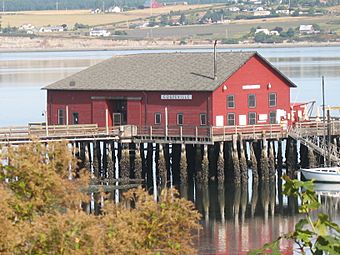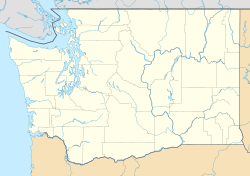Coupeville grain wharf facts for kids
Quick facts for kids |
|
|
Coupeville grain wharf
|
|
|
U.S. Historic district
Contributing property |
|

Coupeville grain wharf in 2008
|
|
| Location | NW Alexander Road, Coupeville, Washington |
|---|---|
| Built | c. 1900 |
| Architect | Multiple |
| Part of | Central Whidbey Island Historic District (ID73001869) |
| Designated CP | December 12, 1973 |
The Coupeville grain wharf is a special kind of dock built in 1905. It is located in Coupeville, Washington. This wharf was once very important for sending out grain grown on Whidbey Island. Today, it is recognized as a significant historical place. It is part of the Central Whidbey Island Historic District. This district was added to the National Register of Historic Places in 1973.
Contents
What is a Wharf?
A wharf is like a platform built out over water. Ships or boats can dock next to it. Wharves are used for loading and unloading goods. They are also used for passengers. The Coupeville grain wharf was built for a specific purpose. It helped move farm products.
Why Was the Coupeville Wharf Important?
In the early 1900s, many farmers lived on Whidbey Island. They grew a lot of grain, like wheat and barley. To sell their grain, they needed a way to get it off the island. Roads were not very good back then. Water travel was the easiest way. The Coupeville grain wharf became a busy place. Farmers brought their grain there. It was then loaded onto ships. These ships would take the grain to other places. This helped the local economy. It also connected the island to bigger markets.
A Hub for Grain Export
The Coupeville grain wharf was a key spot for exporting grain. Exporting means sending goods to another country or region. For Whidbey Island, it meant sending grain to cities. These cities included Seattle and Tacoma. Sometimes, it went even further. The wharf made it possible for farmers to earn money. It also helped feed people in other areas.
How Grain Was Moved
Imagine wagons full of grain arriving at the wharf. Workers would then load the heavy sacks. They put them onto waiting ships. This was hard work. It needed many people. The wharf was designed to make this process easier. It had a strong structure. This allowed it to handle heavy loads. It was a vital part of the island's farming success.
A Historic Landmark
The Coupeville grain wharf is more than just an old dock. It is a historic landmark. This means it is a place with special importance. It tells a story about the past. In 1973, it was listed on the National Register of Historic Places.
What is the National Register of Historic Places?
The National Register of Historic Places is a list. It includes buildings, sites, and objects. These places are important in American history. They might be important for their architecture. They could also be important for their role in events. Being on this list helps protect these places. It means they are recognized for their value. The Coupeville grain wharf is valued for its role in farming and trade.
Part of a Larger Historic Area
The wharf is also part of the Central Whidbey Island Historic District. This district is a larger area. It includes many historic buildings and landscapes. It shows how people lived and worked long ago. The wharf fits right in. It helps tell the story of early life on Whidbey Island. It reminds us of how important farming and trade were.


